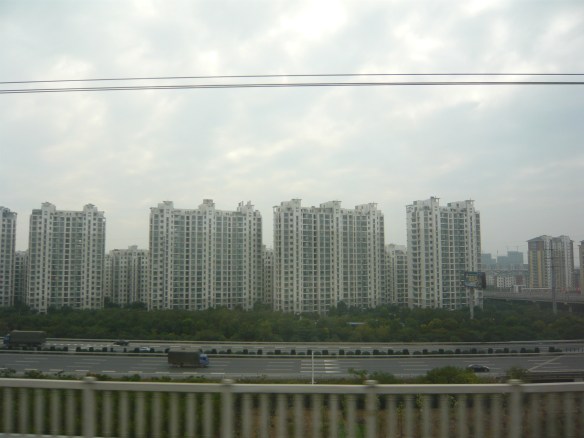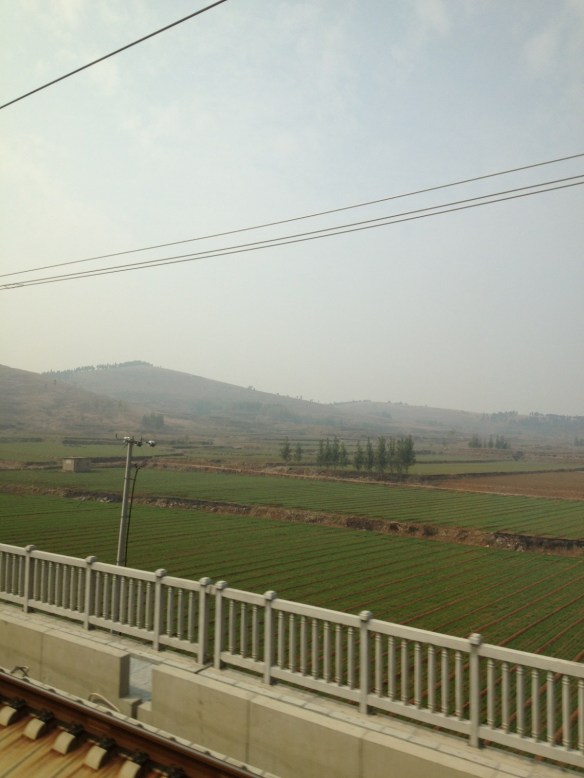Leaving Beijing, we had our first taste of heavy traffic and wet rain. We were ready to leave the dreary weather (or so we hoped) and head south to Shanghai known as Beijing’s decadent little sister. Although I truly enjoyed Beijing’s majestic Forbidden City, ancient hutongs and scattered parks, I really was getting tired of the smoggy, cold weather. Plus the food options were becoming limiting (that happens when you don’t especially like Chinese food) and I knew that I would find much more variety and international fare in cosmopolitan Shanghai. It was time to leave.
Photo below taken during our hour-long taxi ride to Beijing South Railway Station. The further we got out off town and along the Ring Road, the more of these ugly Soviet-era apartment complexes there were. It made me realize just how insanely big Beijing is and how densely the people live. This represents one of hundreds if not thousands of these kinds of living complexes.
In my opinion, there is no better way to see some of the countryside and what is really going on in China than to travel by train. There is something nostalgic about train travel. You can sit back, relax and watch the world go by or in the case of China’s high-speed G trains, watch the world scream by.
The Beijing-Shanghai G Train is one of the longest and highest quality high-speed railways in the world with a designed speed of 350 km per hour. It makes the 1,318 km/819 mile long journey between Beijing and Shanghai take a mere 4 hours and 48 minutes with a brief stop at Nanjing. Launched in June of 2011, the railway was the first one designed for speeds up to 380 km/hour (236 miles/hour), making it the fastest train in the world. The journey from Beijing to Shanghai took 3 hours and 58 minutes compared to 9 hours and 49 minutes on parallel railways with conventional trains. However, after a few mishaps shortly after its launch, the train was slowed down to its current rate averaging 300 km per hour/186 miles per hour.
Photo below: Pulling up into the Beijing train station I am amazed by its modernity and vastness. There are railways everywhere.
Entering Beijing’s train station which is extremely modern (except for the bathrooms: Squat toilets of course). Security was tight and the place was packed.
An up close look at a G Train. Impressive!
There are rows and rows of G Trains waiting for its passengers to board. Each train has a “sightseeing” class with only four luxurious seats, one section of first-class seats (with about twenty-four seats) and 16 trains of regular coach seats.
Leaving Beijing there are tons of buildings in the midst of construction. We made a joke that the national bird of China is the “Crane”.
Per GMO (9/2011), “over 200 skyscrapers are under construction in China today. This is equivalent to the total number of skyscrapers in the U.S. today”.
As the train slowly rolls out of Beijing, passing by one new building conglomerate after the other, it becomes evident what is really going on in China.
“A giant smog of unreality hangs over Chinese property. SocGen calculates that over the last decade, China has completed 16 billion square meters of floor space. This is equivalent to building Rome every two weeks” (SocGen, June 23, 2011)”.
As we would soon witness during our five hour train ride, this construction boom has resulted in vast “Ghost cities” across China in which there are no inhabitants and the cranes cease to be working. The China National Bureau of Statistics and GMO estimate that there will be up to 75 million new homes built this year.
Per the Financial Times*:
“After a decade of soaring prices, signs are that the world’s most populous nation faces its first real estate crash. That would be dire for other countries that rely on China to fuel their own economic growth”.
Some scary trends:
- Home prices in Beijing have risen by about 150 percent in the past four years.
- Residential transactions are down 11.6 percent from last year, all across China.
- Analysts say an urban apartment costs 8-10 times the average annual income nationwide. In Beijing and Shanghai the multiple is closer to 30.
- Construction accounts for 13 percent of the economy, one-quarter of all investment and 40 percent of steel use.
*Source: Financial Times “A lofty ceiling reached” (12/14/2011 by Jamil Anderlini).
As we head out of Beijing, passing by all the look-a-like buildings and apartment complexes, the G Train finally starts to pick up speed reaching of dizzying 306 km/hr or 190 miles/hour. It is the fastest speed I’ve ever traveled by train and my stomach felt it.
Finally we had left Beijing and were in the countryside and it was beautiful ….but not for long.
Ghost cities appeared in the distant horizon and it freaked me out….they were everywhere!
This photo below spooked me the most. We were in the middle of nowhere and in the distance there was a gigantic “Ghost City” where everything had stopped in time, uncompleted. The initial belief of the Chinese government and real estate tycoons was “we will build and they will follow”. Not so sure if it is true.
After almost five hours of passing ghost town after ghost town, I was fascinated and in shock. I have never seen such massive construction and building anywhere before. It is phenomenal. In a country where property construction accounts for an estimated 13% of GDP in the world’s second largest economy, what will happen when the real estate bubble comes to a half? The economic ramifications for China, its people and the world are frightening. Let’s hope for a soft landing.
Arrival at Shanghai’s Rail Station…..and on to the next adventure.
Stay Tuned…more Shanghai surprises coming soon!




















